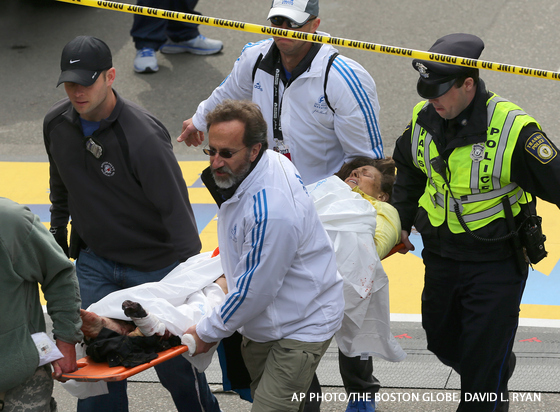Treating Injured in Aftermath of Boston Explosions
Dr. Martin Levine, a Marathon Volunteer and TouroCOM Faculty Member, on Site at Time of Boston Attacks

It was almost 3 P.M. on Monday and Martin Levine, DO, associate dean and professor of family medicine at Touro College of Osteopathic Medicine (TouroCOM), was on Boylston Street in Boston, in front of “Tent A,” the main medical tent where runners are treated after they finish the marathon. He had been in the tent helping the athletes and had left to find other runners he could assist. Suddenly Dr. Levine heard an explosion, felt its concussive force, looked in the direction of the blast and saw a plume of white smoke about a half block away. He yelled into the tent to make room for casualties, and proceeded toward the blast when a second one went off.
"I got to the wounded and immediately started trying to put compresses and tourniquets on them," Dr. Levine said. "All the runners had taken off. It was all just bystanders. They had very severe leg injuries." He described one victim whose legs were severed close to the top of his thighs. "We were asking for belts, we used the lanyards holding our credentials as tourniquets to try to stop the bleeding. It was unbelievably horrendous. Wounds weren’t just lacerations – tissue exploded and bones were shattered - if they were there at all. Skin and clothes were still smoking when we got there.”
A former marathon runner himself who loves sports medicine and “giving back,” Dr. Levine has volunteered to work as a physician in the elite athlete recovery area at the Boston marathon for the past 15 years. But Monday's explosions were unlike anything he'd ever seen. He said the doctors, nurses and EMS personnel in the area were well-prepared and capable of taking many more victims because of the teams put together every year by two Boston-based doctors who know emergency medicine, Pierre D’Hemecort, M.D. and Sophia Dyer, M.D., and a medical director, Chris Troyanos. Additionally, last year’s marathon was run in hot weather, giving the team experience treating 2,300 people.
“We were there and ready for mass casualties because we do this every year,” Dr. Levine said. “We were capable of taking many more victims, no matter how severe, because of the three people who put together the medical team…[and] because of last year,” he said. “We knew what was available and how to get it to the injured. We were able to get wheelchairs, backboards and gurneys to evacuate [the injured] from the site into the tent, and to the EMS personnel who further triaged them. Nurses were able to start IVs before the injured got into the ambulances and were taken to the area hospitals. I believed we saved some limbs and perhaps even some lives.”
Last year, Dr. Levine was on the road serving as president of the American Osteopathic Association. Now back at TouroCOM, after his experience in Boston he plans to teach an anti-terrorism class at the medical school. “It will be about terrorism – trying to stop it and being prepared and doing something.”
In the 24 hours since the blast Dr. Levine’s phone has been ringing off the hook from reporters and he has been doing back-to-back interviews with major media outlets, including CNN, the BBC, and his hometown paper in New Jersey. Still, he has had time to reflect on lessons learned. A key one for him, he said, has been what troops overseas go through and how important it is to be aware of their needs.
"They may see this every day. Just walking from Copley Plaza out to Brookline – every time a siren went off, every time a person yelled or screamed, it affects you differently once you’ve seen this," he said.

